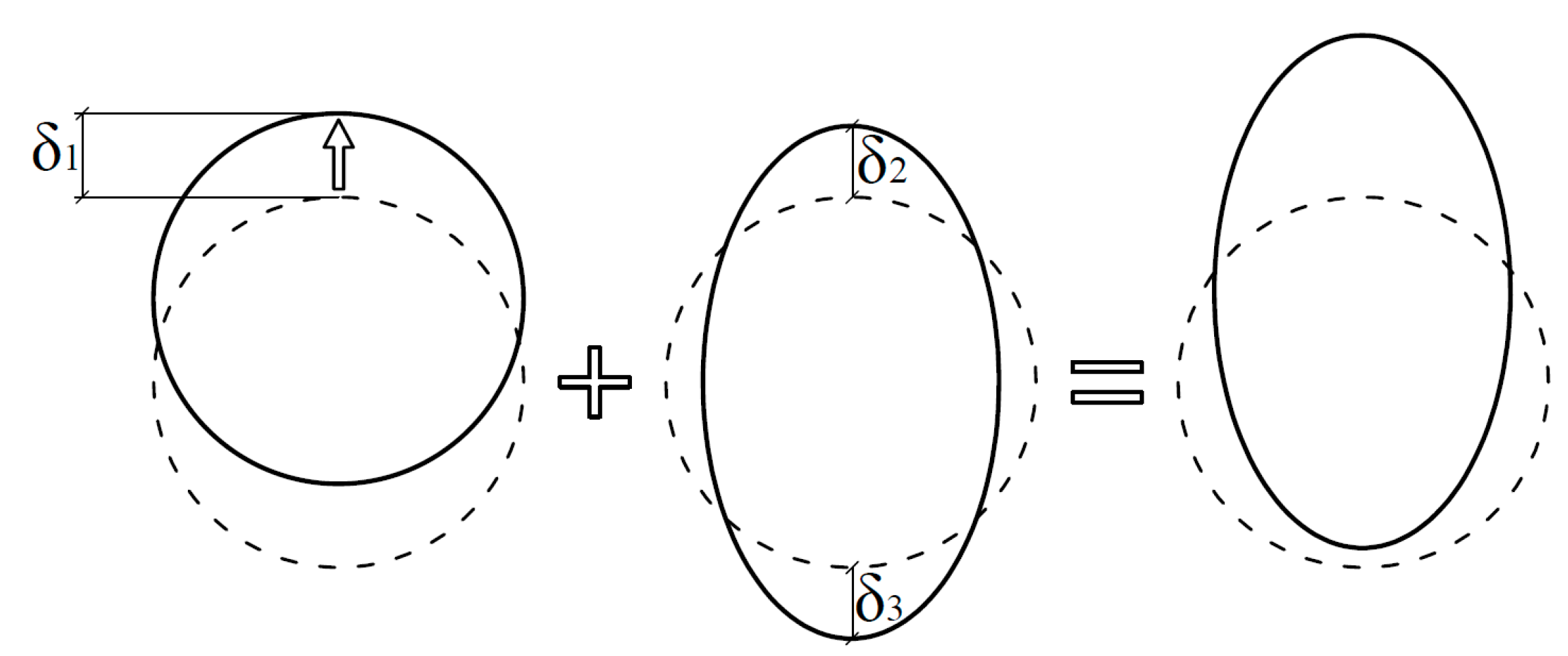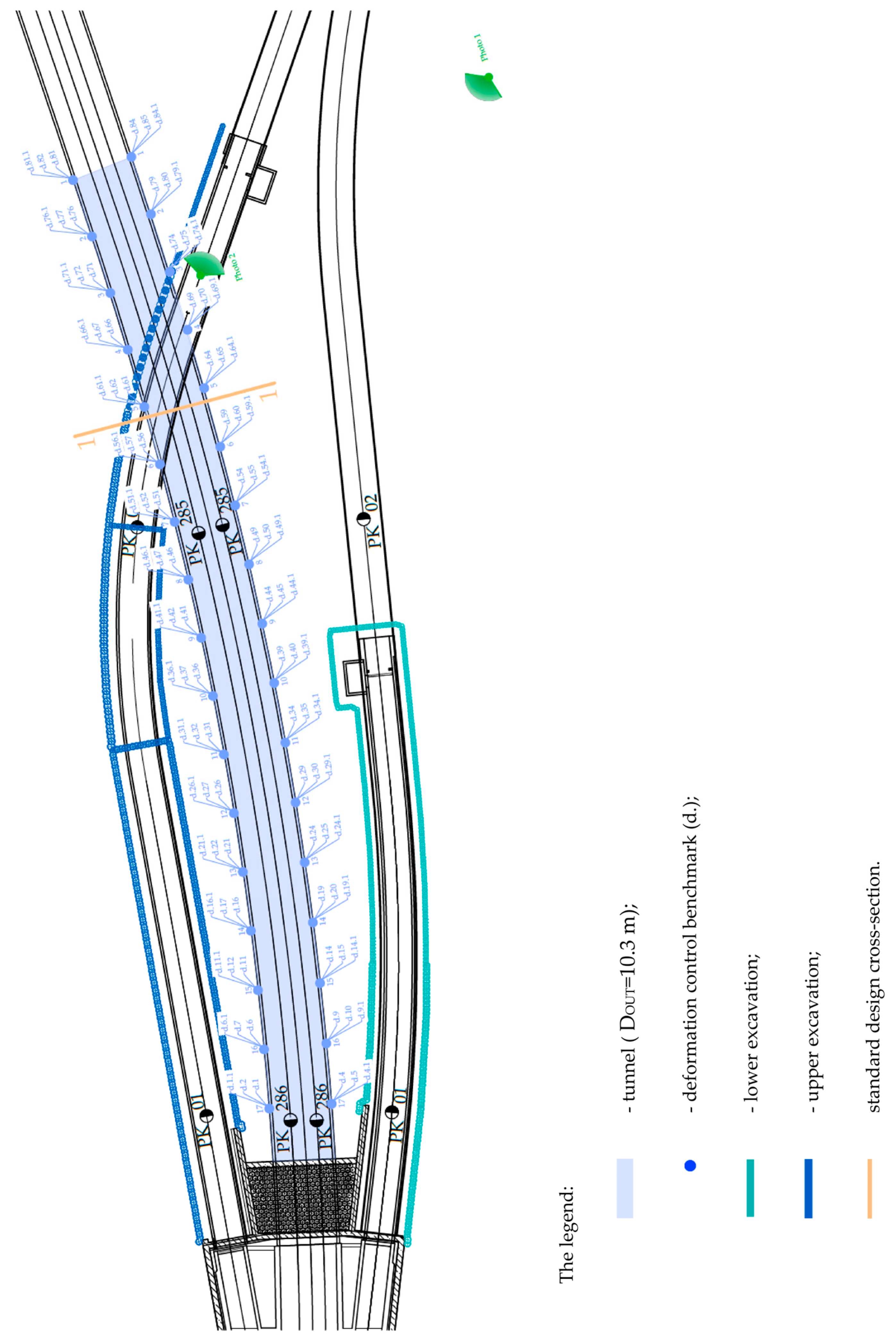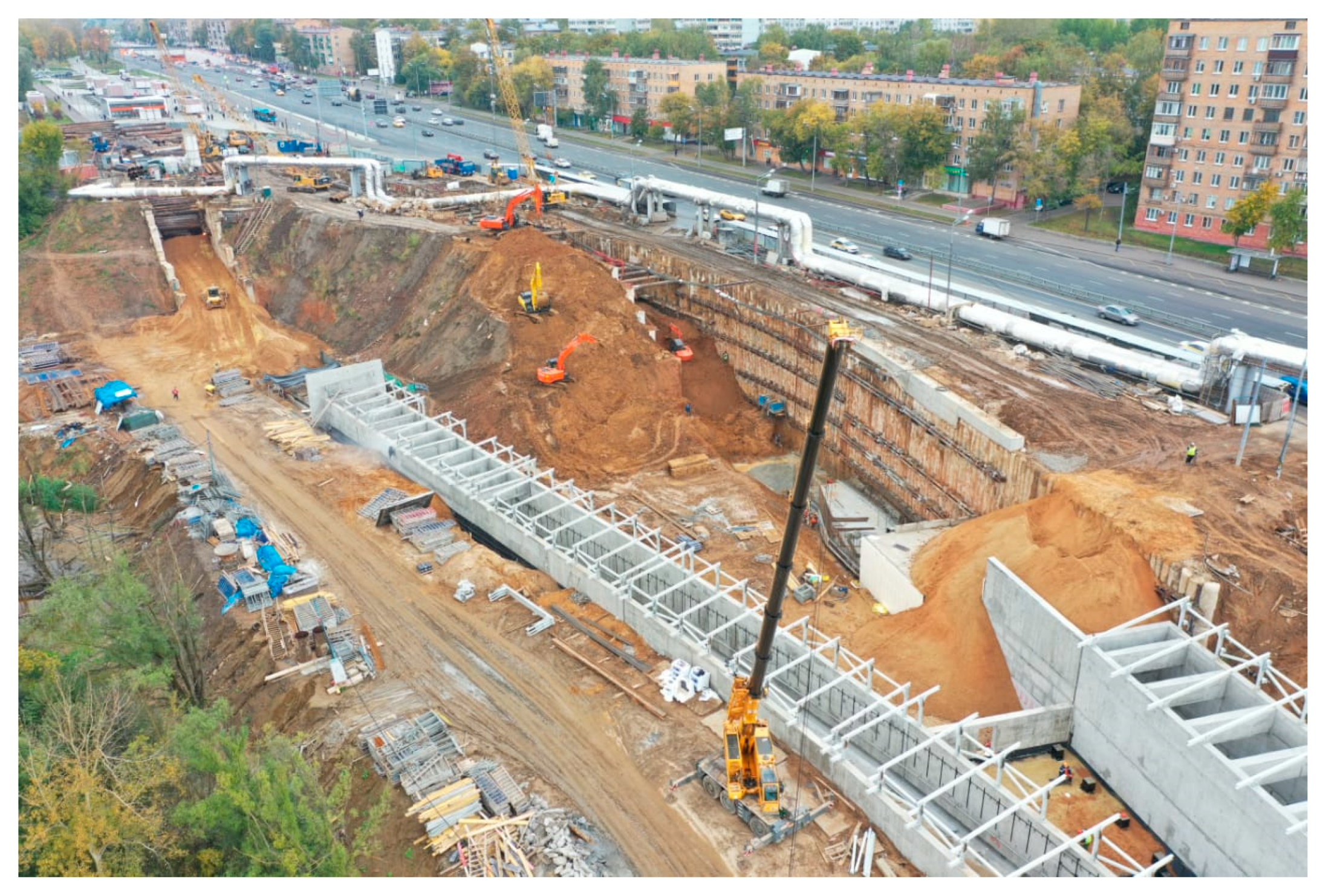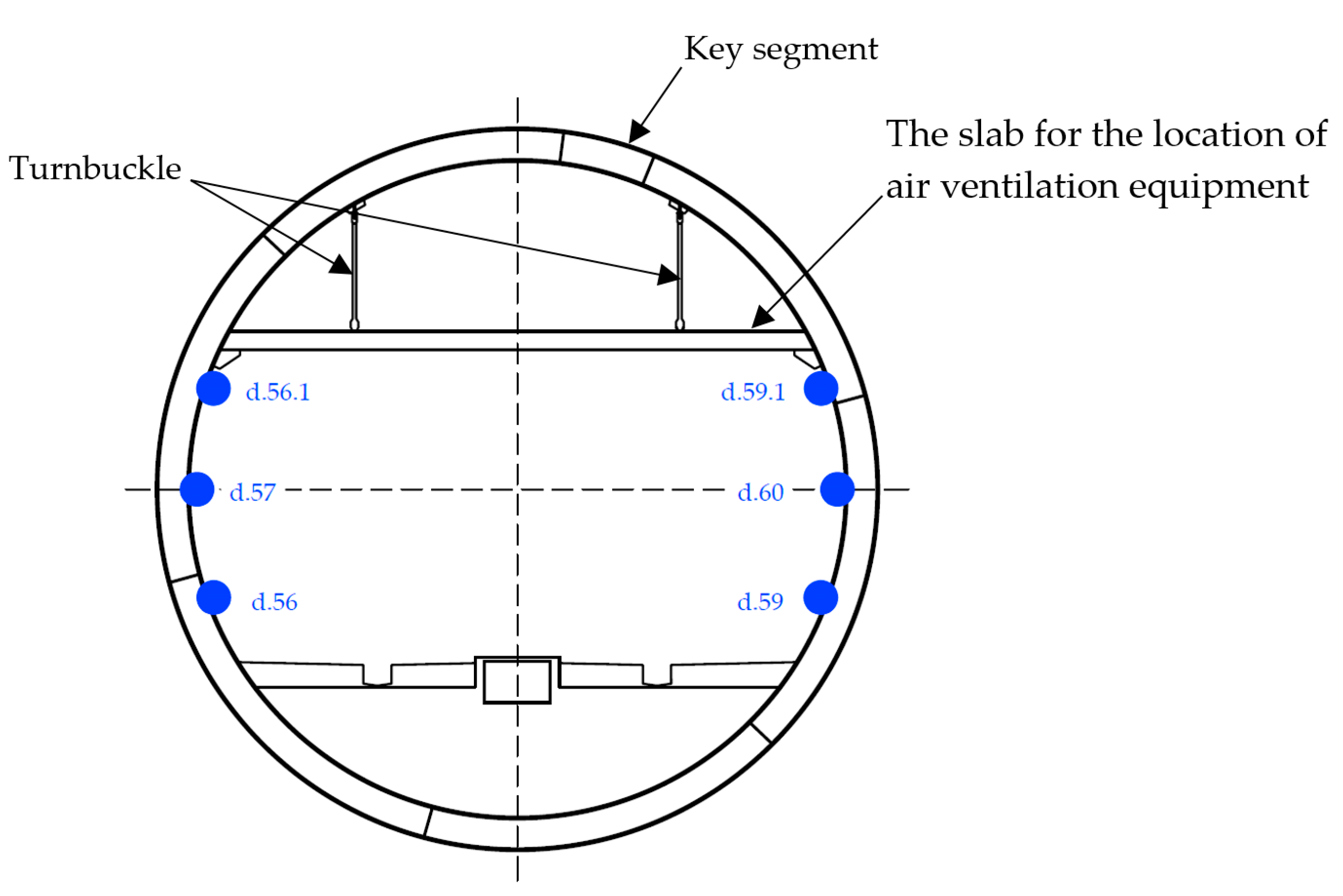Projected Effects of a Deep Excavation Pit on the Existing Metro Tunnel and Findings of Geotechnical Monitoring: A Comparative Analysis
Abstract
:1. Introduction
2. Materials and Methods
3. Results
- −
- distance from the excavation pit in the plan (r);
- −
- depth of the tunnel from the surface to the crown (h);
- −
- depth of the excavation pit (H).
4. Discussion
Author Contributions
Funding
Data Availability Statement
Conflicts of Interest
References
- Yudina, I.M.; Shcherban, D.S.; Troshkina, A.R. Experimental data on the softening of the soil of the base of the experimental pit over time. Eng. Vestn. Don. 2020, 3, 20. [Google Scholar]
- Stiros, S.; Kontogianni, V. Mean deformation tensor and mean deformation ellipse of an excavated tunnel section. Int. J. Rock Mech. Min. Sci. 2009, 46, 1306–1314. [Google Scholar] [CrossRef]
- Huang, X.; Schweiger, H.F.; Huang, H. Influence of Deep Excavations on Nearby Existing Tunnels. Int. J. Geomech. 2013, 13, 170–180. [Google Scholar] [CrossRef]
- Zhou, Z.; Zhou, Y.; Zhang, H.; Chen, S.; Xiang, L.; Wang, L. Effects of Foundation Excavation on Metro Tunnels at Different Locations and Performance of Corresponding Reinforcement Measures: A Case of Shenzhen Metro Line 11, China. Symmetry 2022, 14, 2561. [Google Scholar] [CrossRef]
- Yanru, Z.; Xiangsheng, C.; Biao, H.; Pinghao, W.; Wanshuang, L. Evolution of tunnel uplift induced by adjacent long and collinear excavation and an effective protective measure. Tunn. Undergr. Space Technol. 2023, 131, 1–13. [Google Scholar] [CrossRef]
- Ter-Martirosyan, A.Z.; Cherkesov, R.H.; Isaev, I.O.; Grishin, V.S. The impact of the foundation pit with additional transverse walls on the surrounding building and the assessment of the effectiveness of the measures under consideration. Constr. Geotech. 2021, 12, 54–67. [Google Scholar] [CrossRef]
- Shashkin, A.G.; Ulitsky, V.M. Fundamentals of monitoring the mechanical safety of structures during construction and operation. Ind. Civ. Const. 2017, 12, 6–14. [Google Scholar]
- Zhao, X.; Li, Z.; Dai, G.; Wang, H.; Yin, Z.; Cao, S. Numerical Study on the Effect of Large Deep Foundation Excavation on Underlying Complex Intersecting Tunnels. Appl. Sci. 2022, 12, 4530. [Google Scholar] [CrossRef]
- Ter-Martirosyan, A.Z.; Kivlyuk, V.P.; Isaev, I.O.; Shishkina, V.V. Analysis of the Calculated Prerequisites for the Geotechnical Forecast of New Construction on the Surrounding Buildings. Zhilishch. Stroit. 2022, 9, 57–66. [Google Scholar] [CrossRef]
- Vermeer, P.A.; Brinkgreve, R.B.J. Manual of Plaxis; Balkema: Rotterdam, The Netherlands, 2001. [Google Scholar]
- NIP-Informatika. Available online: http://www.nipinfor.ru/publications/10063/ (accessed on 3 March 2023).
- Brinkgreve, R.B.J.; Broere, W. Plaxis Material Models Manual; Delft University of Technology: Delft, The Netherlands, 2006. [Google Scholar]
- Schanz, T.; Vermeer, P.A.; Bonnier, P.G. The Hardening Soil Model: Formulation and Verification. In Beyond 2000 in Computational Geotechnics; Balkema: Rotterdam, The Netherlands, 1999; pp. 281–297. [Google Scholar] [CrossRef]
- Mirny, A.Y.; Ter-Martirosyan, A.Z. Applications of modern mechanical soil models. Geotechnics 2017, 1, 20–26. [Google Scholar]
- Kawa, M.; Pula, W.; Truty, A. Probabilistic analysis of the diaphragm wall using the hardening soil-small (HSs) model. Eng. Struct. 2021, 232, 111869. [Google Scholar] [CrossRef]
- Sukkarak, R.; Likitlersuang, S.; Jongpradist, P.; Jamsawang, P. Strength and stiffness parameters for hardening soil model of rockfill materials. Soil. Found. 2021, 61, 1597–1614. [Google Scholar] [CrossRef]
- Ready, B.; Krisnamurti; Nurtjahjaningtyas, I. Analysis of slope stability in soft soil using hardening soil modeling and strengthening of bamboo mattress. Int. J. Geom. 2020, 19, 226–234. [Google Scholar] [CrossRef]
- Likitlersuang, S.; Chheng, C.; Keawsawasvong, S. Structural modelling in finite element analysis of deep excavation. J. GeoEngineering 2019, 14, 121–128. [Google Scholar] [CrossRef]
- Alipour, A.; Eslam, A. Design adaptations in a large and deep urban excavation: Case study. J. Rock Mech. Geotech. Eng. 2019, 11, 389–399. [Google Scholar] [CrossRef]
- Rencher, A.C.; Schaalje, G.B. Linear Models in Statistics; John Wiley & Sons: Hoboken, NJ, USA, 2008. [Google Scholar]
- Ou, C.-Y.; Teng, F.; Li, C.-W. A simplified estimation of excavation-induced ground movements for adjacent building damage potential assessment. Tunn. Undergr. Space Technol. 2020, 106, 103561. [Google Scholar] [CrossRef]
- Ershov, E.B. Applying the determination factor to the general case of linear regression estimated using different versions of the least squares method. Econ. Math. Meth. 2002, 38, 107–120. [Google Scholar]
- Preene, M. Assessment of settlements caused by groundwater control. Geotech. Engng. 2000, 143, 177–190. [Google Scholar] [CrossRef]
- Wood, A.M. The Circular Tunnel in Elastic Ground. Geotechnique 1975, 25, 115–127. [Google Scholar] [CrossRef]
- MTSK. Available online: https://mtsk.mos.ru/documents/20526/ (accessed on 4 March 2023).
- Ioannidis, J.P.A. The proposal to lower P value thresholds to. 005. JAMA 2018, 319, 1429–1430. [Google Scholar] [CrossRef]
- Wright, S. Correlation and causation. J. Agric. Res. 1921, 20, 557–585. [Google Scholar]
- Wang, S.; Cui, H. Generalized F test for high dimensional linear regression coefficients. J. Mult. Anal. 2013, 117, 134–149. [Google Scholar] [CrossRef]
- Theodoridis, S.; Koutroumbas, K. Pattern Recognition; Elsevier Inc.: Oxford, UK, 2006. [Google Scholar]









| Point № | Mark | Vertical Displacement (S1), mm | Distance from the Excavation in the Plan (r), m | Depth of the Tunnel from the Surface to the Crown (h), m | Excavation Pit Depth (H), m |
|---|---|---|---|---|---|
| 1 | d.84.1 | −0.2 | 11.0 | 18.50 | 13.70 |
| d.81.1 | 0.5 | 18.8 | 11.80 | 15.60 | |
| 2 | d.79.1 | 0.4 | 5.4 | 11.80 | 16.40 |
| d.76.1 | 0.9 | 13.3 | 2.40 | 16.40 | |
| 3 | d.74.1 | 7.6 | 0.0 | 2.40 | 16.40 |
| d.71.1 | 4.0 | 7.5 | 2.40 | 16.30 | |
| 4 | d.69.1 | 16.1 | 0.0 | 2.40 | 16.40 |
| d.66.1 | 12.2 | 2.0 | 2.40 | 16.60 | |
| 5 | d.64.1 | 20.7 | 4.8 | 2.40 | 16.60 |
| d.61.1 | 22.9 | 0.0 | 2.40 | 17.10 | |
| 6 | d.59.1 | 20.4 | 9.3 | 1.85 | 17.30 |
| d.56.1 | 29.4 | 0.7 | 1.85 | 17.60 | |
| 7 | d.54.1 | 16.7 | 13.2 | 1.85 | 18.50 |
| d.51.1 | 24.0 | 4.1 | 1.85 | 18.50 | |
| 8 | d.49.1 | 9.9 | 14.7 | 8.00 | 19.00 |
| d.46.1 | 15.0 | 5.2 | 8.00 | 19.00 | |
| 9 | d.44.1 | 6.0 | 16.9 | 8.00 | 19.45 |
| d.41.1 | 10.9 | 7.2 | 8.00 | 19.45 | |
| 10 | d.39.1 | 0.0 | 18.0 | 8.00 | 20.00 |
| d.36.1 | 4.2 | 8.3 | 8.00 | 20.00 | |
| 11 | d.34.1 | −1.8 | 18.1 | 9.80 | 20.90 |
| d.31.1 | 2.3 | 8.6 | 9.80 | 20.90 | |
| 12 | d.29.1 | −3.3 | 17.9 | 9.80 | 21.45 |
| d.26.1 | 0.7 | 8.3 | 9.80 | 21.45 | |
| 13 | d.24.1 | −4.4 | 17.6 | 9.80 | 21.70 |
| d.21.1 | 0.7 | 7.9 | 9.80 | 21.70 | |
| 14 | d.19.1 | −4.0 | 17.4 | 16.70 | 22.00 |
| d.16.1 | 0.0 | 7.6 | 16.70 | 22.00 | |
| 15 | d.14.1 | −4.2 | 16.6 | 16.70 | 22.30 |
| d.11.1 | 0.4 | 6.9 | 16.70 | 22.30 | |
| 16 | d.9.1 | −4.8 | 15.6 | 16.70 | 23.80 |
| d.6.1 | −0.2 | 6.0 | 16.70 | 23.80 | |
| 17 | d.4.1 | −4.7 | 14.6 | 16.70 | 24.25 |
| d.1.1 | −1.1 | 5.0 | 16.70 | 24.25 |
| Point № | Mark | Horizontal Displacement (S2), mm | Distance from the Top (r), m | Depth of the Tunnel from the Surface to the Crown (h), m | Depth of the Upper Excavation Pit (H), m | Distance from the Bottom of the Excavation Pit to the Bottom of the Tunnel (d), m |
|---|---|---|---|---|---|---|
| 1 | d.84.1 | 1.3 | 11.0 | 18.50 | 13.70 | 10.00 |
| d.81.1 | 1.1 | 18.8 | 11.80 | 15.60 | 10.00 | |
| 2 | d.79.1 | 2.2 | 5.4 | 11.80 | 16.40 | 10.00 |
| d.76.1 | 0.9 | 13.3 | 2.40 | 16.40 | 10.00 | |
| 3 | d.74.1 | 3.4 | 0.0 | 2.40 | 16.40 | 10.20 |
| d.71.1 | 1.0 | 7.5 | 2.40 | 16.30 | 10.20 | |
| 4 | d.70 | −5.1 | 0.0 | 2.40 | 16.40 | 11.80 |
| d.66.1 | 3.5 | 2.0 | 2.40 | 16.60 | 11.80 | |
| 5 | d.64.1 | −9.8 | 4.8 | 2.40 | 16.60 | 13.80 |
| d.62 | 2.4 | 0.0 | 2.40 | 17.10 | 13.80 | |
| 6 | d.59.1 | −11.4 | 9.3 | 1.85 | 17.30 | 13.00 |
| d.56.1 | 2.6 | 0.7 | 1.85 | 17.60 | 13.00 | |
| 7 | d.54.1 | −8.5 | 13.2 | 1.85 | 18.50 | 9.30 |
| d.51.1 | −7.0 | 4.1 | 1.85 | 18.50 | 9.30 | |
| 8 | d.49.1 | −5.0 | 14.7 | 8.00 | 19.00 | 9.50 |
| d.46.1 | −9.8 | 5.2 | 8.00 | 19.00 | 9.50 | |
| 9 | d.44.1 | −2.1 | 16.9 | 8.00 | 19.45 | 9.30 |
| d.41.1 | −10.8 | 7.2 | 8.00 | 19.45 | 9.30 | |
| 10 | d.39.1 | 5.3 | 18.0 | 8.00 | 20.00 | 9.30 |
| d.37 | −6.4 | 8.3 | 8.00 | 20.00 | 9.30 | |
| 11 | d.34.1 | 11.4 | 18.1 | 9.80 | 20.90 | 6.50 |
| d.32 | −3.1 | 8.6 | 9.80 | 20.90 | 6.50 | |
| 12 | d.29.1 | 13.3 | 17.9 | 9.80 | 21.45 | 6.00 |
| d.27 | 3.8 | 8.3 | 9.80 | 21.45 | 6.00 | |
| 13 | d.24.1 | 13.1 | 17.6 | 9.80 | 21.70 | 5.50 |
| d.22 | −5.8 | 7.9 | 9.80 | 21.70 | 5.50 | |
| 14 | d.19.1 | 12.3 | 17.4 | 16.70 | 22.00 | 5.00 |
| d.16.1 | 4.4 | 7.6 | 16.70 | 22.00 | 5.00 | |
| 15 | d.14.1 | 9.9 | 16.6 | 16.70 | 22.30 | 4.70 |
| d.12 | −4.8 | 6.9 | 16.70 | 22.30 | 4.70 | |
| 16 | d.9.1 | 5.6 | 15.6 | 16.70 | 23.80 | 3.20 |
| d.6.1 | −8.9 | 6.0 | 16.70 | 23.80 | 3.20 | |
| 17 | d.05 | 2.6 | 14.6 | 16.70 | 24.25 | 2.68 |
| d.02 | −10.8 | 5.0 | 16.70 | 24.25 | 2.68 |
| Parameter | S1 | r | h | H |
|---|---|---|---|---|
| S1 | 1 | - | - | - |
| r | −0.62 | 1 | - | - |
| h | −0.77 | 0.41 | 1 | - |
| H | −0.53 | 0.32 | 0.62 | 1 |
| Scheme № | Soil Model | Distance from the Bottom of the Tunnel to the Bottom of the Design Scheme (l) *, m | M-W Coefficient Taken (+)/Not Taken (−) into Account | Tunnel Displacement at the Stage of Excavation to the Design Reference Mark of the Excavation Pit Bottom, mm | ||
|---|---|---|---|---|---|---|
| Model 1 (Point 5, d.61.1) | Model 2 (Point 6, d.56.1) | Model 3 (Point 7, d.51.1) | ||||
| 0 ** | - | - | − | 22.9 | 29.4 | 24.0 |
| 1 | LE | 5.2 | + | 150.7 | 146.8 | 133.3 |
| 2 | LE with 3E and 5E | 5.2 | − | 72.0 | 69.2 | 56.4 |
| 3 | MC | 5.2 | + | 184.7 | 182.3 | 163.8 |
| 4 | MC with 3E and 5E | 5.2 | + | 79.9 | 71.6 | 58.6 |
| 5 | MC | 2.6 | + | 124.6 | 120.3 | 102.1 |
| 6 | MC with 3E and 5E | 2.6 | + | 55.8 | 48.1 | 37.2 |
| 7 | MC | 5.2 | − | 180.0 | 176.7 | 152.5 |
| 8 | MC with 3E and 5E | 5.2 | − | 78.3 | 68.9 | 57.1 |
| 9 | MC | 2.6 | − | 121.9 | 117.3 | 98.2 |
| 10 | MC with 3E and 5E | 2.6 | − | 49.8 | 43.2 | 34.6 |
| 11 | HS | 5.2 | + | 28.0 | 27.4 | 22.1 |
| 12 | HS | 5.2 | − | 26.6 | 26.8 | 21.1 |
| 13 | HSS | 5.2 | + | 23.8 | 21.6 | 17.6 |
| 14 | HSS | 5.2 | − | 22.8 | 20.8 | 16.8 |
Disclaimer/Publisher’s Note: The statements, opinions and data contained in all publications are solely those of the individual author(s) and contributor(s) and not of MDPI and/or the editor(s). MDPI and/or the editor(s) disclaim responsibility for any injury to people or property resulting from any ideas, methods, instructions or products referred to in the content. |
© 2023 by the authors. Licensee MDPI, Basel, Switzerland. This article is an open access article distributed under the terms and conditions of the Creative Commons Attribution (CC BY) license (https://creativecommons.org/licenses/by/4.0/).
Share and Cite
Ter-Martirosyan, A.Z.; Kivliuk, V.P.; Isaev, I.O.; Rud, V.V. Projected Effects of a Deep Excavation Pit on the Existing Metro Tunnel and Findings of Geotechnical Monitoring: A Comparative Analysis. Buildings 2023, 13, 1320. https://doi.org/10.3390/buildings13051320
Ter-Martirosyan AZ, Kivliuk VP, Isaev IO, Rud VV. Projected Effects of a Deep Excavation Pit on the Existing Metro Tunnel and Findings of Geotechnical Monitoring: A Comparative Analysis. Buildings. 2023; 13(5):1320. https://doi.org/10.3390/buildings13051320
Chicago/Turabian StyleTer-Martirosyan, Armen Z., Valery P. Kivliuk, Ilya O. Isaev, and Victoria V. Rud. 2023. "Projected Effects of a Deep Excavation Pit on the Existing Metro Tunnel and Findings of Geotechnical Monitoring: A Comparative Analysis" Buildings 13, no. 5: 1320. https://doi.org/10.3390/buildings13051320







